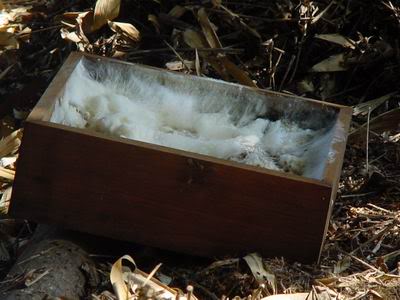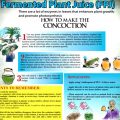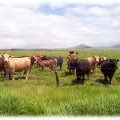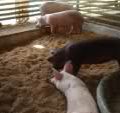In natural farming, Indigenous Microorganism (IMO) is becoming popular among farmers. This Indigenous microorganism (IMO) has been successfully tried by government agriculturists, academic researchers, non-profit organizations and farmers alike. They have found that IMO is useful in removing bad odors from animal wastes, hastening composting, and contributing to crops’ general health.
Beneficial Indigenous Microorganism (BIM)
How to Make Your Own Indigenous Microorganism (IMO):
1. Cook a kilo of rice, preferably organic. After cooling, put the cooked rice in a wooden, earthen or ceramic container. Avoid plastic or aluminum.
2. Cover the mouth of the container completely with cloth or paper, fixed in place with a rubber band, to prevent water or small insects from getting in.
3. Put the covered container, protected from possible rain, under the trees, in a bamboo grove, a forest floor, or wherever a thick mat of leaves has formed. Leave it there for three days.
4. After whitish moldy filaments have formed, transfer the entire contents of the container to a larger glass or earthen jar and add one kilo of brown sugar or molasses, preferably organic.
5. Cover the jar with clean cloth or paper, fixed with a rubber band. Keep the jar in a dark, cool place. Let it ferment for seven days, until it appears muddy. This is your IMO concoction.

IMO growing in a wooden lunch box. Image from thainaturalfarming.com
How to Use Indigenous Microorganism (IMO)
Mix two spoonfuls of the concoction with a liter of water. Spray the diluted solution around chicken coops and pig pens to remove unpleasant odors, on your compost pile to hasten decomposition, or on your crops to improve their general health by controlling pests and serving as foliar fertilizer.
IMO Video (Tagalog):
By making your own Indigenous Microorganisms (IMO), you can free yourself of buying costly harmful chemicals and make a lot of savings while maintaining good bacteria in your area.
Lacto Bacilli
One of the major workhorse beneficial indigenous microorganism used in natural farming is lacto bacilli. This particular beneficial microorganism is popularly used in composting that specifically arrest foul odors associated with anaerobic decomposition. Lactic acid bacteria thrive and feed on the ammonia released in the decomposition normally associated with foul odors. So if you need to decompose or ferment wastes less foul odors, lactic acid bacteria is the specific bacteria to use. Its application in organic farming is enormous. Lactic acid bacteria is specially used in natural piggery. Pigs are allowed to roam their pens where the floors (substrate) are made of compost, soil and other organic matter like sawdust, sprayed with lactic acid bacteria serum. There is no need to clean up the pens of excretions and urines. The lactic acid bacteria do the “cleansing”. They convert these wastes into unharmful ones through this natural way of decomposition. So there is no need to clean and no need to worry about foul odors. Another application is for raising organic chickens. The serum is diluted and added to water and feeds of the chickens. With the lactic acid bacteria intake of the chickens, it helps better assimilation of nutrients of feeds through better breakdown of food, thus, more nutritious food extraction. Likewise, in aquaculture, one of the problem is related to water quality. Poor water quality stresses the fish which in turn stunts their growth and affects their health. This is very evident specially on high density and tank aquaculture. The ammonia produced through fish excretions pollute the water and stress the fish. With regular addition of this beneficial microorganisms to the water, this ammonia problem is minimized, if not fully arrested. It helps hasten or complete the denitrification or converting wastes into forms not harmful to fish.
Spraying diluted solution of lactic acid bacteria serum to the plant and soil helps plant growth and makes them more healthy. As it is applied to the soilor the leaves, these beneficial bacteria aid in the decomposition process, thus allowing more food to be available and assimilated by the plant.
Lactic acid bacteria is also known to produce enzymes and natural antibiotics aiding effective digestion and has antibacterial properties, including control of salmonella and e. coli. To farmers, what are observed are the general health of the plants and animals, better nutrient assimilation, feed conversion and certain toxins eliminations.
Here’s a simple method of collecting this type of microorganism. Lactic acid bacteria can be collected from the air. Pour rice wash (solution generated when you wash the rice with water) on a container like plastic pot with lid. Allow air gap at least 50-75% of the container. The key here is the air space. Cover the (not vacuum tight, allowing air still to move into the container) container with lid loosely. Put the container in a quiet area with no direct sunlight. Allow the rice was to ferment for at least 5-7 days. Lactic acid bacteria will gather in 5-7 days when temperature is 20-25 degrees C. Rice bran will be separated and float in the liquid, like a thin film, smelling sour. Strain and simply get the liquid. Put this liquid in a bigger container and pour ten parts milk. The original liquid has been infected with different type of microbes including lacto bacilli. And in order to get the pure lacto bacilli, saturation of milk will eliminate the other microorganisms and the pure lacto bacilli will be left. You may use skim or powdered milk, although fresh milk is best. In 5-7 days, carbohydrate, protein and fat will float leaving yellow liquid (serum), which contain the lactic acid bacteria. You can dispose the coagulated carbohydrate, protein and fat, add them to your compost pile or feed them to your animals. The pure lactic acid bacteria serum canbe stored in the refrigerator or simply add equal amount of crude sugar (dilute with 1/3 water) or molasses. Do not use refined sugar as they are chemically bleached and may affect the lactic acid bacteria. The sugar or molasses will keep the lactic acid bacteria alive at room temperature. One to one ratio is suggested although sugar, regardless of quantity is meant simply, serving as food for the bacteria to keep them alive. Now, these lactic acid bacteria serum with sugar or molasses will be your pure culture.
To use, you can dilute this pure culture with 20 parts water. Make sure water is not chemically treated with, like chlorine. Remember, we are dealing with live microorganisms and chlorine can kill them. This diluted form 1:20 ratio will be your basic lactic acid bacteria concoction. Two to four tablespoons added to water of one gallon can be used as your basic spray and can be added to water and feeds of animals. For bigger animals, the 2-4 tablespoons of this diluted lactic acid bacteria serum should be used without diluting it further with water. Lactic acid bacteria serum can be applied to plant leaves to fortify phyllosphere microbes, to soil and compost. Of course, it will help improve digestion and nutrient assimilation for animals and other applications mentioned before. For any kind of imbalance, be it in the soil or digestive system, lacto bacilli can be of help.
Forest Beneficial Microorganisms
One technique in culturing other beneficial microorganism is getting them from your local aged forest. One way is finding a healthy old robust tree in your local forest. Check the humus litter around the tree. The tree should have accumulated real deep humus, litter, compost of at least 2 feet to 1 yard deep. In this area through observation, we can deduce that soil fertility and microbial biodiversity are high. Our goal is to trap and culture these diversed, aged beneficial indigenous microorganisms.
The technique that we use in trapping these microorganisms is the use of carbohydrate like cooked rice. Microorganisms will be attracted to food. So generally, what we do is to put the cooked rice on a flatter container with lid. For example, you can use a plastic lunch box and add about an inch of cooked rice allowing air space in the container. What is important here is a larger area to trap those microorganisms. It is suggested that you cover this container with metal netting or equivalent protecting it from animals like rats that may undig your container once you bury it in the litter, humus of your local forest. In 2-10 days (relative to temperature), you may undig your container and will notice contamination of microorganisms like white and other color molds on the cooked rice. The cooked rice has been infected now with microorganisms of your local forest. The next step is to add 1/3 amount of crude sugar or molasses to the infected cooked rice. After a week, the concoction will look like sticky, liquidy rice. You may then add equal amount of crude sugar or molasses to keep it for storage, arresting microbial activities, in a cooler area. To use, you may dilute this serum with 20 parts water. This diluted form shall then serve as your basic forest microorganisms. You may strain it and put in a container. Another version of trapping similar forest microorganisms is simply getting the litter, humus and spreading them sparingly to the top your cooked rice. Forest leaf molds can also be used. The same procedure will be followed as described in the culture of local forest microorganisms.
Bamboo Microorganisms
Another method of gathering microorganism is through burying your container with cooked rice on bamboo plants litter. Apparently, bamboo through observation and experience in the East, attracts powerful beneficial microorganisms as the roots of the bamboo exude sugary substances that attract beneficial microorganisms. The same procedure is followed as described before in its culture.
Plant Specific Microorganisms
An equal specific method is trapping beneficial microorganisms of specific plants you want to grow or growing. For example, ifyou want to trap and culture beneficial microorganisms from rice, you should then select healthy, vigorous rice plant, cut them and put inverted cooked rice container over the cut rice plant. Again, beneficial microorganisms specific to rice will be attracted to the cooked rice. You can use this technique to any other plant of choice and the same procedure of culture will be used as previously described.
Rhizobium Nitrogen-Fixing Bacteria
One of the most popular nitrogen-fixing bacteria is rhizobium. It is amazing that when we coat our legumes with these specific bacteria, legumes grow well and more nitrogen is fixed on the soil. Amazingly enough, basic culture of these beneficial bacteria is simple. Once we have seen those nodules created by the bacteria fixing nitrogen on the roots of the legumes, we can assume that there are lotsof these rhizobia and nitrogen fixed. Just pull out the legumes plants on a very specific stage, especially towards their flowering/fruiting stage. A simple method of culture is simply get the soil with these leguminous bacteria and mix with crude sugar with equal ratio of crude sugar. Rhizobium bacteria will proliferate feeding on the sugar and thus can be mixed with your next batch of legume seeds for inoculation.
Our concoction or recipe of beneficial indigenous microorganism (BIM) is 50% lactic acid bacteria and the rest is 50% of the other microorganisms cultured. So you may use 1 part forest microorganism, 1 part bamboo microorganism and 1 part specific plant microorganism mixed with 3 parts or 50% lacto bacilli. The more diversed microbes, the better. However, we will still use 50% of the total beneficial indigenous microorganisms to be lactic acid bacteria. The rest you can experiment and make your own observations and formulations. I cannot really tell you specifically what microbes we get from the different sources we have mentioned. As a rule, I only use the above BIM for plants. For animals, I use just pure lacto bacilli for we haveisolated this as described. We have used the bamboo microorganisms for fermenting feeds to be fed to animals.
Different type of microorganisms thrive on different type of foods. As you can see, we use principally carbohydrates and sugars. But it will beequally important that we provide these beneficial indigenous microorganisms with other nutrients. In fact, we mix or add fermented plant extracts (fermented plant and fruit juices), ginger-garlic nutrients, brown rice vinegar and fish amino acid. That’s why in most instances, we mix these beneficial indigenous microorganisms with bionutrients to make it more effective.
Bionutrients
In the creation of biological nutrients, bionutrients, the basic process is the traditional fermentation. Fermentation process is a better system than simple extraction like boiling the plant materials, through infusion like making tea. In the United States, where compost tea is getting popular inorganic agriculture, compost ismade into tea, sugar or molasses are added, fermented toincrease microbial population.
A simple general formula or recipe in fermentation can be done for plants. For example, seaweeds. If you simply infuse seaweeds (which are quite difficult to breakdown, therefore hard to extract active ingredients), you may not get a more potent extracted active ingredients. If you ferment the same materials by adding sugar or molasses, it is easily broken down (biologically) by microorganisms and thus making nutrient more available. Microorganisms get their energy from sugar in fermenting the materials. Most healthy foods are fermented foods. Through fermentation, food are easily broken down, enzymes created, nutrition improved. That’s the reason why fermented foods like yogurt or kimchi (Korean pickles) are more nutritiousthan plain milk or vegetables.
In making bionutrients, the simple formula isto add 1/3 crude sugar or molasses and mixed with materials to be fermented and extracted. For example, let’s take papaya fruit fermented extract. We chop as thinly as possible ripe papaya, unwashed and unpeeled. We then add 1/3 crude sugar or molasses to the total weight or approximate volume of the papaya materials. Put the materials withat least 50-75% air gap and cover loosely lid and let it ferment for at least a week. After a week, you will notice some molds and microbial infections and will start smelling sweet, sour and alcoholic. The materials are then strained and liquid generated will be your pure fruit papaya extract. You can dilute this with 20 parts water. This diluted form can be used as bionutrient, using 2-4 tablespoons per gallon of water. Again, this extract can beadded to animal drinking water and feeds, to compost pile or sprayed/watered to plants leaves and roots. This will be a good source of nutrient for plants or animals, and also for our beneficial indigenous microorganisms. Papaya extract is good source of enzyme pappain, beta-carotene and Vitamin C for example. So extract any plant material and just try to find out what kind of nutrients they have you can use for animal and plant nutrition. Should the materials you intend to use for extraction do not have much moisture (as compared to our papaya fruit example), you may add water enough to the level that will moisten all the materials.
Ginger-Garlic Extract
The original recipe of the natural farmers of Korea use not only the ginger and garlic materials, but also Chinese herbs like Angelica acutiloba, Glycurrhiza uralensis and Cinnamomum loureirii. These Chinese herbs have one basic common denominator, they are good for digestion. We have used simply equal amount of ginger and garlic, less these Chinese herbs. This is our natural antibiotics we use for plants and animals. Remember the high level of sulfur on garlic? It is a good fungicide. The ginger-garlic extract is quite different from the plant extracts we have discussed. We soak the chopped up ginger and garlic in beer or wine overnight or 12 hours. Then we add 1/3 crude sugar and let it ferment for a couple of days like 5-7 days. Then we add alcohol which stabilizes and arrests fermentation. The alcohol should be at least 40% proof. The active ingredients of the ginger and garlic is extracted in finale with the use of alcohol similar to herbal tincture we are familiar with in homeopathy. Remember that ginger and garlic are highly medicinal and highly nutritious. We have used them as natural antibiotics and in preventive medicine. We have used this concoction on chicks and chickens and have made them healthy throughout. Of course, we also use them when we see animal weakening and when they are sick. We have used them on fungal problems of plants. We have used them for rheumatism. The uses are enormous both for plants and animals.
Sources:
– RVerzola
– Indigenous Microorganisms: Grow Your Own Beneficial Indigenous Microorganisms and Bionutrients In Natural Farming by Gil A. Carandang







Thank you for sharing this knowledge. It will help me greatly. God bless you back many folds.
thanks for the information given it can help in transfoming lives of many within shotest period of time and world is going organic the idea should be embraced and put into practice.
iTS REALLY A GOOD ONE
ask ko lang po anung microorganisms ang meron sa IMO
Thank you for the knowledge given to us the famers,
Thank you po,,,,nkuha ko ang sagot s research ko,,,,
thanks alot
May natutunan na ako na magagamit ko para mawala ang masamang Amoy sa pig pen ko,maraming salamat po…
organic farming is heaven's method…..
Gud am.Ask ko lang po kung pwede ipagsabay ang LAS,IMO,FPJ at Tea manure?Thanks po.
very helpful information. more power! =)
What if milk is not mixed with the fermented rice wash? Would it be still effective as odor reducer?
Maganda po ang organic farming i want to learn more about this.
thank you
What a wonderful technology. like it
EM — binibili / IMO – home-made — Email me: eatmodule@yahoo.com for free ebook. thank you. God bless.
ano po ba ang pinagka iba ng EM At IMO?
THANK YOU TO SHOW US HOW TO MAKE OUR OWN IMO….
or ung imo 1 lng po…sori.
isasama po b yong kanin na lalagyan ng molases or yong kanin lng po?
ask lang po maam kung alin po ang mas short ang time sa pag decompost ung IMO ba or ANC.. o di kaya pagsabayan ang IMO at ANC sa isang compost bin sa pagdecompost? anu po ang mas madali?
ask lang po maam kung alin po ang mas short ang time sa pag decompost ung IMO ba or ANC.. o di kaya pagsabayan ang IMO at ANC sa isang compost bin sa pagdecompost? anu po ang mas madali?